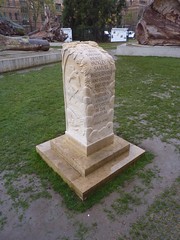February 26, 2013
Fragile art
 A while ago I mentioned the interesting issue of how often mathematics papers are wrong. Here is the opposite side of the coin: how often art about mathematics is wrong.
A while ago I mentioned the interesting issue of how often mathematics papers are wrong. Here is the opposite side of the coin: how often art about mathematics is wrong.
D. Huylebrouck sent me a great article: Belgian town of De Panne blunders with artwork: Unfortunate miscalculation
Basically, the big golden ratio/Fibonacci artwork has an addition error making the numbers wrong. As noted in the article, it is not the only one. I was reminded of the famous sculpture Kryptos outside the CIA that also contains a typo making decryption hard.
The obvious conclusion is that artists don't double-check their artworks.
Normally this is not needed, since all the content exists on some readily accessible surface/physical layer and the implied deeper layers of meaning emerge from that layer using robust human inference. When we see Michelangelo's David we see the marble form, interpret it in terms of human appearance and mythology, and then extrapolate deeper levels based on context. But while the artwork in De Panne can be interpreted this way (golden ratio concrete block, spiral, numbers as a first level, leading to layers of mathematical and art history meaning) the erroneous symbols create an accidental, nearly parasitical meaning: rather than showing the regularity and infinite perfection of mathematics, it now leads the viewer to consider error, confusion and mistakes. Kryptos is even worse: here much of the meaning resides in the existence of a hidden but in principle decipherable layer, and the typo destroys some of the content in that layer.
It is even more obvious in case of informative artworks like commemorative sculptures or memorials: here there is some information layer linked to the real world the sculpture is intended to reveal and perhaps put into a deeper context, but of course that link can be erroneous. These kinds of artwork are fragile in an informational sense: a single letter or number can destroy their symbolism.
Recognizing whether you are working in a fragile domain (a single error can change meaning strongly) or a robust domain (errors merely nudge the final result) is important, whether in science or art.
Posted by Anders3 at February 26, 2013 05:05 PM